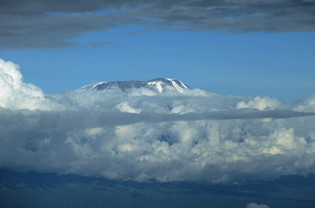
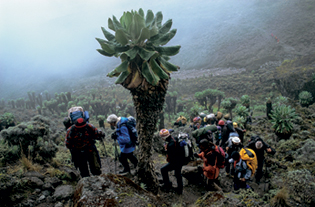
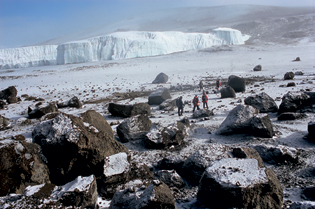
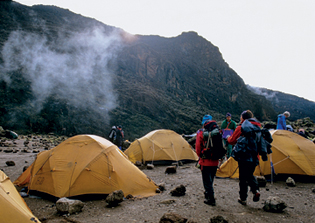
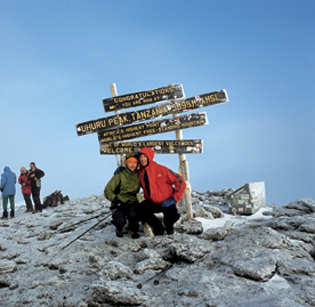
THE LAST SNOWS OF KILIMANJARO
The snows of Mount Kilimanjaro will have disappeared in fifteen years time. Good reason then to attempt an ascent of the roof of Africa at an altitude of nearly 6,000m.
TEXT & PHOTOS : Laurence Fleury
How astonished the first European explorers must have been in the XIXth century, when faced with this white summit emerging from the jungle, just off the equator! The highest mountain in Africa, revered by the Masai as the House of the Gods as well as the Mountain of Water, its thawing ice supplies their fields and pastureland. Situated to the north of Tanzania, it is one of the largest volcanoes in the world, made up of three main summits: the Shira, created from a volcanic eruption nearly 800,000 years ago, the Mawenzi and the Kibo; the latter being the highest summit, whose apex, the Uhuru peak, culminates at 5,895m. It is said that Mount Kibo formerly accommodated an elephant cemetery; a legend recounted by Hemingway in “The snows of Kilimanjaro”. Conquered for the first time by a German photographer, Hans Meyer, in 1889, the ascent of the Kilimanjaro was only repeated fourteen times from then until 1945. Today, over 30,000 tourists make an attempt at its summit each year.
From the green hell to the eternal snows
The ascent is far from banal. We set out in shorts, in a tropical jungle, ending up five days later at –20°C in the snow. Several routes lead to the summit, but the most frequented are the Marangu, nicknamed the “Coca Cola Route”, and the “Machame” or “Whisky Route”, which is steeper and less popular. At the gateway to the “Machame” (1,800m) we wait in the sunshine, the temperature at 25°C. Registration, bag weighing (20kg per porter maximum), peddlers haggling over rain capes, which come highly recommended apparently. It’s a good start!
We set off mid-afternoon into the “rainforest” where the first raindrops slap down onto the tree ferns. The tone is set: a humid atmosphere, stifling air and extremely muddy terrain. We wade as far as the first bivouac: the tents are put up one after the other and there are nearly a hundred of them in total! It’s a real cosmopolitan village where trekkers from the west rub shoulders with the African porters amidst a rather good-natured atmosphere.
Higher up a unique ecosystem of weird plants rise up through the mist like totems: some giant senecio kilimanjari or tree groundsel, with leaves that look like old leather, which retain water and have developed a system of resistance to the cold. This endemic flora is likely to disappear as the glacier melts. An army of porters snake their way into the distance across the slopes of the Kili. A slow procession of silhouettes, luggage on their heads, walk towards the next camp. The air is lighter with the altitude, but all of a sudden the legs are heavy and the blood pounds in the temples. Mountain sickness lies in wait for an overly rash mountaineer, so you have to make headway slowly. There’s nothing technical about the ascent of the Kilimanjaro; the slope rising steadily up to the summit, yet 60% of the attempts result in failure, often due to a lack of acclimatisation.
At the end of the third day, the snows finally reveal themselves above Camp Barranco (3,950m). “In the past, we found snow at 3,000m and it was up to our thighs”, recalls Elias, a Tanzanian guide who has racked up 300 ascents since 1961. Today it’s a godsend to find the summit white. With the rain over the past week, the mountain is covered in a fine layer of powdery snow beyond 5,000m.
The end of the ice in 2020
At midnight, a string of headtorches head out from Camp Barafu (4,600m) towards the stars. Each foot is slowly placed onto the moraine, the muscles are stiff, the breath short. After a tough climb up to Stella Point (5,700m), the roof of Africa finally appears before us. A vast, infertile plateau which culminates in a gentle slope up to Uhuru Peak, Liberty Peak, rechristened as such in 1961 during the country’s independence from Britain. The Kilimanjaro is one of the largest volcanoes on Earth, and its summit “as vast as the world, immense, high and incredibly white in the sunshine”, wrote Hemingway. The landscape is barely real with these blocks of ice measuring over 50 metres high; an accumulation of several thousands of years of snow, which seem to be stranded there, like icebergs. During the XXth century, the glacier lost 80% of its surface area, shrinking back from 12 to 2 square kilometres.
Dropping down to the edge of the Kibo crater is a bit like penetrating the bowels of the Earth. The ground is hot, the smell of sulphur nips at your nose, and the steep slopes plunge over a hundred metres down. Nobody knows how long ago the last eruption was, but it’s not impossible that the Tanzanian giant will awaken one day.
The last snows of Kilimanjaro are doomed to disappear, but there’s nothing to suggest that the melting will accelerate. If our more ecological behaviour is not enough to halt this phenomenon, at least etymology (Kilima: mountain, Njaro: water, in Swahili) will ensure the snows of Kilimanjaro are eternal.
Read the rest of the article in the Mountain Report magazine - Where to find ?

